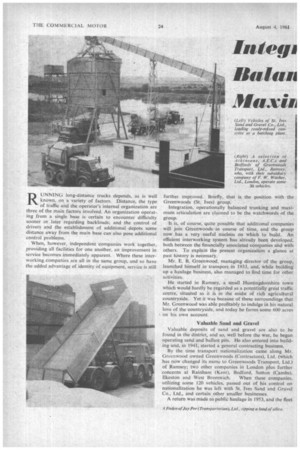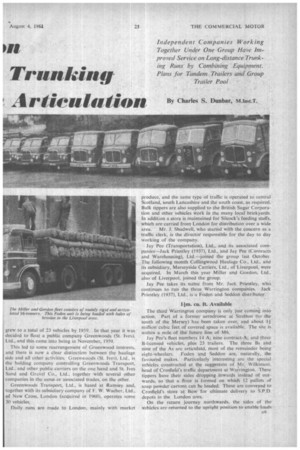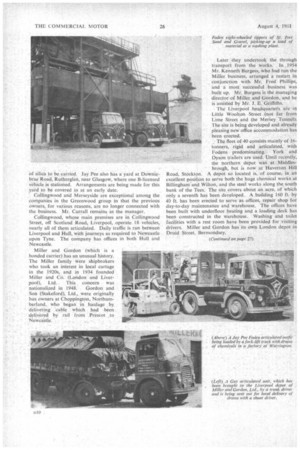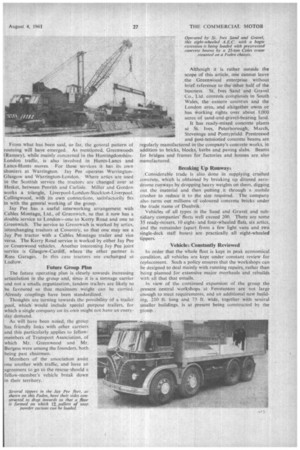Intega
Page 52

Page 53

Page 54

Page 57

If you've noticed an error in this article please click here to report it so we can fix it.
on
Milan
Trunking
IPlaxiL
Articulation
By Charles S. Dunbar, M.Inst.T.
RUNNING long-distance trucks depends, as is well known, on a variety of factors. Distance, the type of traffic and the operator's internal organization are three of the main factors involved. An organization operating from a single base is certain to encounter difficulty sooner or later regarding backloads; and the control of drivers and the establishment of additional depots some distance away from the main base can also pose additional control problems.
When, however, independent companies work together, providing all facilities for one another, an improvement in service becomes immediately apparent. Where these interworking companies are all in the same group, and so have the added advantage of identity of equipment, service is still further improved. Briefly, that is the position with the Greenwoods (St. Ives) group.
Integration, operationally balanced trunking and maximum articulation are claimed to be the watchwords of the group-.
It is, of course, quite -prossible that additional companies will join •Greenwoods in course of time, and the group now has a very useful nucleus on which to build. An efficient interworking system has already been developed, both between the financially associated companies and with others. To explain the present organization a glance at past history is necessary.
Mr. E. B. Greenwood, managing director of the group, launched himself in transport in 1933, and, while building up a haulage business, also managed to find time for other activities.
He started in Ramsey, a small HuntingdonShire town which would hardly be regarded as a potentially great traffic centre, situated as it is in the midst of rich agricultural countryside. Yet it was because of these surroundings that Mr. Greenwood was able profitably to indulge in his natural love of the countryside, and today he farms some 600 acres on his own account.
Valuable Sand and Gravel
Valuable deposits of sand and gravel are also to be found in the district, and so, well before the war, he began operating sand and ballast pits. He also entered into building and, in 1941, started a general contracting business.
By the time transport nationalization came along Mr. Greenwood owned Greenwoods (Contractors), Ltd. (which has now changed its name to Greenwoods Transport, Ltd.) of Ramsey; two other companies in London plus further concerns at Rainham (Kent), Bedford, Sutton (Cambs), Ilkeston and West Bromwich. When these companies, utilizing some 120 vehicles, passed out of his control on nationalization he was left with St. Ives Sand and Gravel Co., Ltd., and certain other smaller businesses.
A return was made to public haulage in 1953, and the fleet grew to a total of 23 vehicles by 1959. In that year it was decided to float a public company Greenwoods (St. Ives). Ltd., and this came into being in November, 1959.
This led to some rearrangement of Greenwood interests, and there is now a clear distinction between the haulage side and all other activities. Greenwoods (St. Ives). Ltd., is the holding company controlling Greenwoods Transport, Ltd.. and other public carriers on the one hand and St. Ives Sand and Gravel Co., Ltd., together with several other companies in the same or associated trades, on the other.
Greertwoods Transport, Ltd., is based at Ramsey and. together with its subsidiary company of F. W. Wacher. Ltd., of New Cross, London (acquired in 1960). operates some 30 vehicles.
Daily runs are made to London. mainly with market produce, and the same type of traffic is operated to central Scotland, south Lancashire and the south coast, as required. Bulk tippers are also supplied to the British Sugar Corporation and other vehicles work in the many local brickyards. In addition a store is Maintained for Silcock's feeding stuffs, which are carried from London for distribution over a wide area. Mr. J. Shadwell, who started with the concern as a traffic clerk, is the director responsible for the day to day working of the company.
Jay Pee (Transportation), Ltd., and its associated companies—Jack Priestley (1937), Ltd.. and Jay Pee (Contracts and Warehousing), Ltd.—join.ed the group last October. The following month Coffingwood Haulage Co, Ltd.. and its subsidiary, Merseyside Carriers, Ltd., of Liverpool. were acquired. In March this year Miller and Gordon, Ltd.. also of Liverpool, joined the group.
Jay Pee takes its name from Mr. Jack Priestley, who continues to run the three Warrington companies. Jack Priestley (1937), Ltd., is a Foden and Seddon distributor.
ifm. Cu. ft. Available The third Warrington company is only just coming into action. Part of a former aerodrome at Stretton (to the south of the Mersey) has been taken over, and about 1-f million cubic feet of covered space is available. The site is within a .mile of the future line of M6. Jay Pee's fleet numbers 14 A; nine contract-A; and three B-licensed vehicles, phis 23 trailers. The three Bs and nine of the As are articulatd, most of the remainder being eight-wheelers. Foden and Seddon are, naturally, the favoured makes. Particularly interesting are the special vehicles constructed at the suggestion of Mr._ Wilkinson, head of Crosfield's traffic department at Warrington. These tippers have their sides dropping inwards instead of outwards, so that a floor is formed on which 12 pallets of soap powder cartons can be loaded. These are conveyed to Crosfield's store at Bow for ultimate delivery to S.P.D. depots in the London area.
On the return journey northwards, the sides of the vehicles are returned to the upright position to enable loads of silica to be carried. Jay Pee also has a yard at Downiebrae Road, Rutherglen, near Glasgow, where one B-licensed vehicle is stationed. Arrangements are being made for this yard to be covered in at an early date.
Collingwood and Merseyside are exceptional among the companies in the Greenwood group in that the previous owners, for various reasons, are no longer connected with the business. Mr. Currall remains as the manager.
Collingwood, whose main premises are in Collingwood Street, off Scotland Road, Liverpool, operate 18 vehicles, nearly all of them articulated. Daily traffic is run between Liverpool and Hull, with journeys as required to Newcastle upon Tyne_ The company has offices in both Hull and Newcastle.
Miller and Gordon (which is a bonded carrier) has an unusual history. The Miller family were shipbrokers who took an interest in local cartage in the 1920s, and in 1934 founded Miller and Co. (London and Liverpool), Ltd. This concern was nationalized in 1948. Gordon and Son (Stakeford), Ltd, were originally bus owners at Choppington, Northumberland, who began in haulage by delivering cable which had been delivered by rail from Present to Newcastle. • Later they undertook the through transport from the works. In 1954 Mr. Kenneth Burgess, who had run the Miller business, arranged a restart in conjunction with Mr. Fred Phillips, and a most successful business was built up. Mr. Burgess is the managing director of Miller and Gordon, and he is assisted by Mr. J. E. Griffiths.
The Liverpool headquarters are in Little Woolton Street (not far from Lime Street and the Mersey Tunnel). The site is being developed and already pleasing new office accommodation has been erected.
The fleet of 40 consists mainly of 16tonners, rigid and articulated, with Fodens predominating. York and Dyson trailers are used. Until recently, the northern depot was at Middles brough, but is now at Haverton Hill Road, Stockton. A depot so located is, of course, in an excellent position to serve both the huge chemical works at Billingham'and Wilton, and the steel works along the south bank of the Tees. The site covers about an acre, of which only a seventh has been developed. A building 160 ft. by 49 ft. has been erected to serve as offices, repair shop for day-to-day maintenance and warehouse. The offices have been built With underfloor heating and a loading deck has been constructed in the warehouse. Washing and toilet facilities with a rest room have been provided for visiting drivers. Miller and Gordon has its own London depot in Druid Street, Bermondsey. From what has been said, so far, the general pattern of routeing will have emerged. As mentioned, Greenwoods (Ramsey), while mainly concerned in the HuntingdonshireLondon traffic, is also involved in Hunts-Lancs and Lanes-Hunts moves.. For these services it has its own shunters at Warrington. Jay Pee operates WarringtonGlasgow and Warrington-London. Where artics are used in the Scottish service the tractors are changed over at Hesket, between Penrith and Carlisle. Miller and Gordon works a triangle, Liverpool-London-Stockton-Liverpool. CoRingwood, with its own connections, satisfactorily fits in with the general working of the group.
Jay Pee has a useful interworking arrangement with Cables Montagu, Ltd., of Greenwich, so that it now has a double service to London—one to Kerry Road and one to Greenwich. The service to Greenwich is worked by arties, interchanging tractors at Coventry, so that one may see a • 3ay Pee tractor with a Cables Montagu trailer and vice versa. The Kerry Road service is worked by either Jay Pee or Greenwood vehicles. Another interesting Jay Pee joint service is Glasgow-Cardiff, where the other partner is Ross Garages. In this case tractors are exchanged at Ludlow.
Future Group Plan The future operating plan is clearly towards increasing articulation in the group and. since it is a tonnage carrier and not a smalls organization, tandem trailers are likely to be favoured so that maximum weight can be carried. Already couplings have been standardized.
Thoughts are turning towards the possibility of a trailer pool, which would include special purpose trailers, for which a single company on its own might not have an everyday demand.
As will have been noted, the group has friendly links with other carriers and this particularly applies to fellowmembers of Transport Association, of which Mr. Greenwood and Mr. Burgess were among the founders, both being past chairmen.
Members of the association assist one another with traffic, and have an agreement to go to the rescue should a fellow-member's vehicle break down in their territory.
Although it is rather outside the scope of this article, one cannot leave the Greenwood enterprise without brief reference to the other half of the business. St. Ives Sand and Gravel Co., Ltd. controls companies in South Wales, the eastern counties and the London area, and altogether owns or has working rights over about 1,000 acres of sand-and-gravel-bearing land.
It has ready-mixed concrete plants at St. Ives, Peterborough, March, Stevenage and Pontypridd. Prestressed and post-tensioned concrete beams are regularly manufactured in the company's concrete works, in addition to bricks, blocks, kerbs and paving slabs. Beams for bridges and frames for factories and houses are also manufactured.
Breaking Up Runways ,Considerable trade is also done in supplying crushed concrete, which is obtained by breaking up disused aerodrome runways by dropping heavy weights on them, digging out the material and then putting it through a mobile crusher to reduce it to the size required. The company also turns out millions of coloured concrete bricks under the trade name of Dunbrik.
Vehicles of all types in the Sand and Gravel and subsidiary companies' fleets well exceed 200. There are some 35 ready-mixers, 10 eightand four-wheeled flats, six artics, and the remainder (apart from a few Light vans and two single-deck staff buses) are practically all eight-wheeled tippers, • Vehicles Constantly Reviewed In order that the whole fleet is kept in peak economical condition, all vehicles are kept under constant review for replacement. Such a policy ensures that the workshops can be designed to deal mainly with running repairs, rather than being planned for extensive major overhauls and rebuilds with all that that entails.
In view of the continued expansion of the group the present central workshops at Fenstanton are not large enough to meet requirements, and an additional new building, 210 ft. long and 75 ft. wide, together with several smaller buildings, is at present being constructed by the group.








































































































